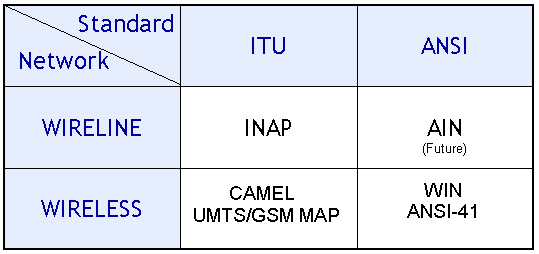
You are here: Intelligent Network & Wireless Protocols Overview > 1 Intelligent Network and Wireless > Intelligent Network and Wireless Protocols
Intelligent Network and Wireless Protocols

This section describes Excels software support for mobile and wireline communications networks. The Intelligent Network (IN) and wireless protocols offered by Cantata were developed by IntelliNet Technologies, a leading provider of IN infrastructure software. Excels platform supports five IntelliNet protocols to access IN and wireless networks:
|
Codec Name |
Description |
Standard |
|---|---|---|
|
Customized Application for Mobile network Enhanced Logic (CAMEL) |
Phase 2, 3, & 4 |
3GPP TS 29.078 (v5.1.0 Release 5) |
|
Universal Mobile Telecommunications System - Mobile Application Part (UMTS-MAP) which includes Global System for Mobile communication - Mobile Application Part (GSM-MAP) |
Phase 1,2,2+, & 3 |
UMTS MAP - 3GPP TS 29.002 V4.2.1 (2000-12) 3G TS 29 002 v3.4.0 (2000-3) |
|
Wireless Intelligent Network (WIN) |
Phase I & II |
TIA/EIA/IS 771 |
|
ANSI - 41 |
ANSI - 41D |
TIA/EIA-41.(1-6) D Dec 1997 |
|
Intelligent Network Application Protocol (INAP) |
CS-1 |
The matrix below shows the IN wireline and wireless protocols supported by telecommunications standards.

A European Telecommunications Standards Institute (ETSI) standard messaging protocol for including IN functions into GSM mobile networks. CAMEL is used when roaming between networks, allowing the home network to monitor and control calls made by its subscribers. CAMEL API allows roaming subscribers access to their full portfolio of Intelligent Network (IN) services. CAMEL is a relatively inexpensive method of allowing telecom operators to add new services to the existing network infrastructure.
A few typical applications include:
Pre-Paid Calling
Personal Numbering
Location dependent services
An ETSI standard messaging protocol used in UMTS/GSM wireless networks to communicate among network elements to support user authentication, equipment identification, and roaming:
Mobile Switching Center (MSC)
Home Location Register (HLR)
Visitor Location Register (VLR)
Equipment Identity Register (EIR)
Short Message Service Center (SMSC)
Authentication Center (AuC)
Typical applications include:
Intelligent Peripheral (IP)
Service Control Point (SCP)
Enhanced Services Platform
The IntelliNet MAP protocol layer provides an easy to use library of C++ classes that can be utilized to develop GSM Mobility Applications.
A Telecommunications Industry Association/American National Standards Institute (TIA/ANSI) standard messaging protocol that enables subscribers in ANSI-41 based wireless networks to use intelligent network services. WIN also supports the network capabilities to provide wireless activities such as automatic roaming, incoming call screening, and voice-controlled services.
Intellinets WIN protocol facilitates the development of platform-independent, transport-independent and vendor-independent WIN services such as:
Hands-Free
Voice-Controlled Services
Voice-Controlled Dialing (VCD)
Voice-Controlled Feature Control (VCFC)
Voice-Based User Identification (VUI)
Incoming Call-Restriction/Control
Calling Name Presentation (CNAP)
Password Call Acceptance (PCA)
Selective Call Acceptance (SCA)
A TIA/ANSI standard messaging protocol used in Code-Division Multiple Access (CDMA) and Time Division Multiple Access (TDMA) wireless networks primarily in the Americas and parts of Asia to communicate among network elements (MSC, HLR, VLR, EIR, SMSC) to support inter-system hand-off, automatic roaming, authentication, and supplementary call features. The ANSI 41D specification (formerly known as IS-41) is primarily used in the wireless network to provide services such as automatic roaming, authentication, intersystem hand-off, and short message service. All wireless network elements use this messaging protocol to communicate.
Typical applications include:
Intelligent Peripheral (IP)
Service Control Point (SCP)
Enhanced Services Platform
Intelligent Network Application Protocol (INAP), an ITU-T specification, allows applications to communicate between various nodes/functional entities of a wireline Intelligent Network. The protocol defines the operations required to be performed between nodes/functional entities for providing Intelligent Network services.
A few typical applications include:
Call Center solutions requiring handling of special service numbers (800 & 900 services)
Local Number Portability
Calling Card registration and authentication including charging and fraud management capabilities
Interactive Voice Response (IVR) systems for small and large business segments
Calling Name delivery
Service Management systems for study of traffic patterns as well as generating call reports and billing records at central administration and billing center.
Future availability of AIN protocol
Cantata plans to offer the Advanced Intelligent Network (AIN) protocol to support ANSI-based, wireline Intelligent Networks in future releases.
Some examples of applications using AIN include:
Toll-free dialing and FreePhone facilities for subscribers
Virtual Private Network Services for closed user groups operating over geographically distributed facilities
Universal Access Number (UAN)
Split Charging capability enabling the subscriber to separately charge personal and business calls made from the same instrument
Call Rerouting and Redistribution based on traffic volume and/or time of day suitable for telemarketing businesses and reservation centers with multiple locations.
Prepaid and Calling Card services
Televoting, whereby franchisees may cast their choice over secure voice response systems, preserving privacy, possible travel time as well as avoiding human tampering of results and other malpractices.